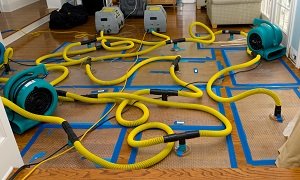Spotlight: Fire/Water Restoration Contractors

Pollutants from fire/water restoration contractor activities can significantly affect the environment, even though these activities are meant to restore the general order of a locale. Response personnel may encounter many different circumstances that could lead to releases of hazardous chemicals, incompatible materials, or materials that are easily diffused, and no health and safety plan or emergency response plan could ever anticipate what might happen at a worksite. There have been many instances of restoration contractors coming onto a site and inadvertently releasing materials that they were intending to contain.
Although many environmental regulations excuse response personnel from liability for costs or damages during the course of rendering care or assistance to others, this does not mean that contractors cannot be held liable for costs or damages as a result of releases that they cause or exacerbate at a worksite. This can happen even if they have gotten all of the necessary permits to conduct their operations.
Environmental Concerns for Fire/Water Restoration Contractors Include:
Examination of area, cleanup of areas, bringing in heavy equipment if needed, and cleanup/removal of trash
- Security during examination of area: because they often don’t know what they may encounter, fire-water restoration contractors have to secure their work areas and make sure that third parties do not enter the work area where they may be exposed to hazardous materials. These may include friable asbestos, byproducts of wood fires such as benzoapyrenes, mixtures of hazardous chemicals or polychlorinated biphenyls (PCBs), among other potential hazardous materials found at disaster sites.
- Cleanup of areas: fire-water restoration contractors often have to clean possessions on and off-site. Often, these possessions may have been affected by chemicals on-site or when water intrusion has occurred, mold can appear. Mold may become airborne and affect contractor employees or third parties. During cleanup activiitres, water containing hazardous and non-hazardous materials may run off-site and affect surrounding properties, local storm sewers, or in the worst case scenarios, drinking water wells.
- Bringing in heavy equipment when needed: spills may occur from tanks containing fuel for heavy equipment or exhaust fumes from equipment may be generated.
- Hazardous and non-hazardous materials may spill during loading/unloading activities.
Transporting waste or materials to or from a jobsite
- Spills may occur while chemicals or equipment are being transported to or from the jobsite, or during loading/unloading.
- Spills may occur while waste, debris, etc. are being transported from the jobsite to a disposal site.
Disposal of waste at non-owned facilities
- Restoration debris may be inadvertently mixed with hazardous waste and then disposed of improperly, causing contamination conditions at the landfill or disposal facility. This may result in claims against the landfill or disposal facility which could come back to the original generator (restoration contractor or their client) of the waste.
- Improper disposal of air conditioning and refrigeration units which could result in fines, penalties, or claims against restoration entities.
- Improper disposal of asbestos, lead, polychlorinated biphenyls (PCBs) containing components which are regulated and should be handled as hazardous waste. Improper removal could result in fines, penalties, cleanup costs, and claims against the restoration entity for bodily injury and property damage.
Insured’s owned premises
- Materials that are being cleaned off-site may contain hazardous materials and could spill at the restoration contractor’s premises.
- Contamination at owned premises could be caused by cleaning/maintenance chemicals or storage of heavy equipment, mobile equipment, or vehicles.
- Storage of paints, chemicals, solvents, etc. at owned premises.
- ASTs used for waste oil, hydraulic fluids, or fuel.
- USTs used for refueling vehicles or heating oil.
Pollution insurance products that fire/water restoration contractors should consider include: Contractors Pollution Liability (CPL), Site Pollution Liability (EIL), Transportation Pollution Liability (TPL), and Non-Owned Disposal Site Coverage NODS.
For more information about coverage for fire/water restoration contractors, please contact us.
Type: Blog
Topic: Fire and Water Restoration